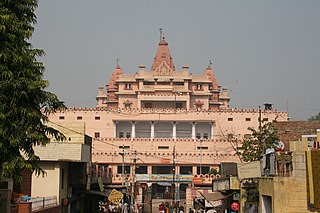
Girnar is an ancient hill in Junagadh, Gujarat, India.

The Dilwara Temples or Delvada Temples are a group of Śvētāmbara Jain temples located about 2+1⁄2 kilometres from the Mount Abu settlement in Sirohi District, Rajasthan's only hill station. The earliest were built by Bhima I and supposedly designed or at least financed by Vastupala, Jain minister of Dholka. They date between the 11th and 16th centuries, forming some of the most famous monuments in the style of Māru-Gurjara architecture, famous for their use of a very pure white marble and intricate marble carvings. They are managed by Seth Shri Kalyanji Anandji Pedhi, Sirohi and are a pilgrimage place for Jains, and a significant general tourist attraction. The Dilwara temples are regarded as the most impressive among Jain temples in Rajasthan.

Junagadh is the city and headquarters of Junagadh district in the Indian state of Gujarat. Located at the foot of the Girnar hills, 355 kilometres (221 mi) southwest of Ahmedabad and Gandhinagar, it is the seventh largest city in the state.

Narsinh Mehta, also known as Narsinh Bhagat, was a 15th-century poet-saint of Gujarat, India, honored as the first poet, or Adi Kavi, of the Gujarati language. Narsinh Mehta is member of Nagar Brahman community. Narsinh became a devotee of Krishna, and dedicated his life to composing poetic works described as bhakti, or devotion towards Krishna. His bhajans have remained popular in Gujarat and Rajasthan for over 5 centuries. Most notably, his composition Vaishnav Jan To was Mahatma Gandhi's favorite and became popular with freedom fighters across India.

Damodarlit. '"roped around the abdomen"' is the 367th name of Vishnu from the Vishnu Sahasranama. The various meanings of the name are given as follows:
Prabhas Patan, historically named Dev Patan, is locality in Veraval, Gujarat. As the site of the Somnath temple and its associated Jyotirlinga, it is an important place of Hindu pilgrimage.

Parikrama or Pradakshina is clockwise circumambulation of sacred entities, and the path along which this is performed, as practiced in the Indic religions – Hinduism, Buddhism, Sikhism and Jainism. In Buddhism, it refers only to the path along which this is performed. Typically, in Indic-religions the parikrama is done after completion of traditional worship and after paying homage to the deity. Parikrama must be done with dhyāna.

Radha-Krishna is the combined form of the Hindu god Krishna with his chief consort and shakti Radha. They are regarded as the feminine as well as the masculine realities of God, in several Krishnaite traditions of Vaishnavism.

In Hinduism, the yatra (pilgrimage) to the tirthas has special significance for earning the punya needed to attain the moksha (salvation) by performing the darśana, the parikrama (circumambulation), the yajna, the Dhyana, the puja (worship), the prarthana, the dakshina, the seva, the bhandara, etc. These sacred places are usually located on the banks of sacred waters, such as sacred rivers or their tributaries, the kundas, the ghats, or the stepwells, or the temple tanks.

Shri Swaminarayan Mandir, Mumbai is a Hindu temple (Mandir) and a part of the Swaminarayan Sampraday. This Swaminarayan Temple is located in the Bhuleshwar area of Mumbai and is the oldest Swaminarayan Mandir in Mumbai, being over a hundred years old.
Virpur is a town in Rajkot district of Gujarat, India. Virpur is the birthplace of saint Jalaram bapa and had a temple dedicated to him here which is popular among pilgrims. Virpur was established and ruled by Koli chieftain Viro Bariyo.

Swaminarayan Mandir, Vadtal headquarters of the LaxmiNarayan Dev Gadi are located in this temple in Vadtal. There are three main shrines in the temple the central shirne of this temple is that of Lakshmi Narayan and RanchodRai. On the right there is idol of Radha Krishna with Swaminarayan in the form of Hari Krishna and the left has Vasudev, Dharma and Bhakti. The wooden pillars of the temple bear colourful wood carvings. There is a dharamsala within the temple premises. Gnyanbaug is a garden to the northwest of the temple gate that has four memorials dedicated to Swaminarayan.

Shri Swaminarayan Mandir, Junagadh, also called ShriRadha Ramana Temple, Junagadh is a Hindu temple in Junagadh, Gujarat, India. This temple was ordered to be built by Swaminarayan himself, the founder of the Swaminarayan Sampradaya.

Damodar Kund(Gujarati: દામોદર કુંડ), located at the foothills of Girnar hills, near Junagadh in the Indian state of Gujarat, is considered a sacred lake as per Hindu beliefs.
Ra Mahipala III was a Chudasama king of Saurashtra region of western India who reigned from 1430 CE to 1451 CE. His capital was at Junagadh.
Khengara was a Chudasama king of Saurashtra region of western India who reigned from 1331 CE to 1351 CE. His capital was at Junagadh.
Mandalika I was a Chudasama King of Saurashtra region of western India who reigned from 1294 CE to 1306 CE. His capital was at Junagadh.

The Krishna Janmasthan Temple Complex is a group of Hindu temples situated in Mathura, Uttar Pradesh, India. There are three main temples inside the premises -- Keshavdevtemple which is dedicated to Krishna, Garbh Griha where Krishna is believed to be born in Dvapar Yuga and Bhagvata Bhavan where presiding deities are Radha Krishna.

Shri Radha Damodar Temple is a Hindu temple dedicated to Hindu deities Radha and Krishna. The temple is situated in Vrindavan of Indian state Uttar Pradesh. In the temple, Krishna is worshiped in the form of Damodar with his consort Radha. It is one of the main seven Goswami temples of Vrindavan. The temple belongs to Gaudiya Vaishnavism tradition and was founded by Jiva Goswami in 1542 CE.






















